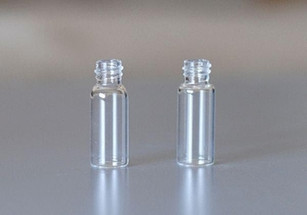Posted by Chrom Tech on 15th Oct 2025
The Advantages of Silane-Treated Vials
The Advantages of Silane-Treated Vials
In chromatography, even minor analyte loss can significantly affect quantitative accuracy—especially in trace-level analyses. Silane-treated vials help prevent this by removing active sites on the inner glass surface where analytes can adsorb. By deactivating the reactive silanol groups within the glass, these vials ensure that samples remain stable and recoverable throughout the analytical process.
How Silane Treatment Works
The silanization process deactivates free hydroxyl (–SiOH) groups found on borosilicate glass surfaces. This is achieved by applying a methylsilylating agent via vapor-phase deposition to the interior of the chromatography vial. The agent reacts with the silanol sites, forming a thin, inert coating that prevents polar or basic analytes from adhering to the glass. This modification improves sample recovery and reduces bias in quantitative analyses—particularly critical for low-abundance compounds.
When to Consider Reduced Surface Activity (RSA™) Vials
In certain applications, even silane-treated vials may not completely prevent adsorption or reaction with sensitive compounds. For these situations, Chrom Tech offers Reduced Surface Activity (RSA™) vials—an advanced alternative designed for analytes that still react with silanized glass. RSA™ vials are manufactured using a proprietary process that eliminates silanol formation on Type 33 borosilicate glass and removes nearly all trace metals. The result is a highly inert surface that prevents hydrolysis and other degradation reactions in bioactive or pH-sensitive samples.
The absence of surface hydroxyl groups (–OH) means RSA™ glass does not exhibit the acidity typical of untreated glass, making it ideal for low-abundance or reactive compounds. If you’re concerned about basic or polar analytes adhering to glass surfaces, consider Chrom Tech’s MicroSolv Reduced Surface Activity Autosampler Vials for maximum analyte recovery and stability.
Benefits of RSA™ Vials
- Allow detection of low-abundance analytes typically adsorbed by standard glass vials
- Minimize pH drift and chemical changes in stored samples
- Prevent sample hydrolysis—RSA™ glass is virtually free of surface metals
- Eliminate meniscus formation when using water as the primary solvent
- Not coated or silanized, yet inherently low in surface reactivity
Choosing Between Silane-Treated and RSA™ Vials
Both silane-treated and RSA™ vials provide enhanced sample integrity compared to untreated glass. The best choice depends on your analyte chemistry and sensitivity requirements:
- Silane-treated vials are ideal for reducing adsorption of polar analytes and improving recovery in general LC and GC workflows.
- RSA™ vials are preferred for ultra-sensitive bioactive, peptide, or low-abundance samples where even minor surface activity can alter results.
Summary
Whether you’re performing trace-level quantitation or working with reactive compounds, vial surface chemistry plays a critical role in data reliability. Contact Chrom Tech to discuss your application needs and determine whether Silane-Treated or Reduced Surface Activity Vials are best suited for your laboratory workflow.
Frequently Asked Questions About Silane-Treated and RSA™ Vials
What is the main advantage of silane-treated vials?
Silane-treated vials deactivate reactive silanol groups on glass surfaces, preventing sample adsorption and ensuring accurate quantitation—especially for low-concentration or polar compounds.
How do RSA™ vials differ from silane-treated vials?
RSA™ vials use a proprietary glass formulation that eliminates silanol groups and surface metals entirely, rather than coating them. This creates an ultra-inert surface ideal for sensitive bioactive analytes.
Which vial should I use for low-abundance bioactive compounds?
For low-abundance or highly reactive compounds, RSA™ vials are recommended for maximum sample recovery and minimal degradation.

